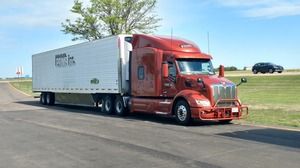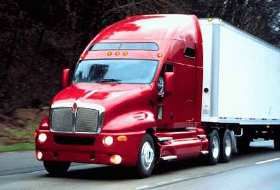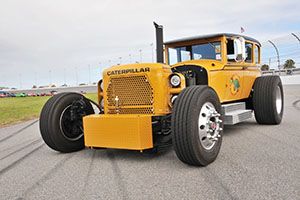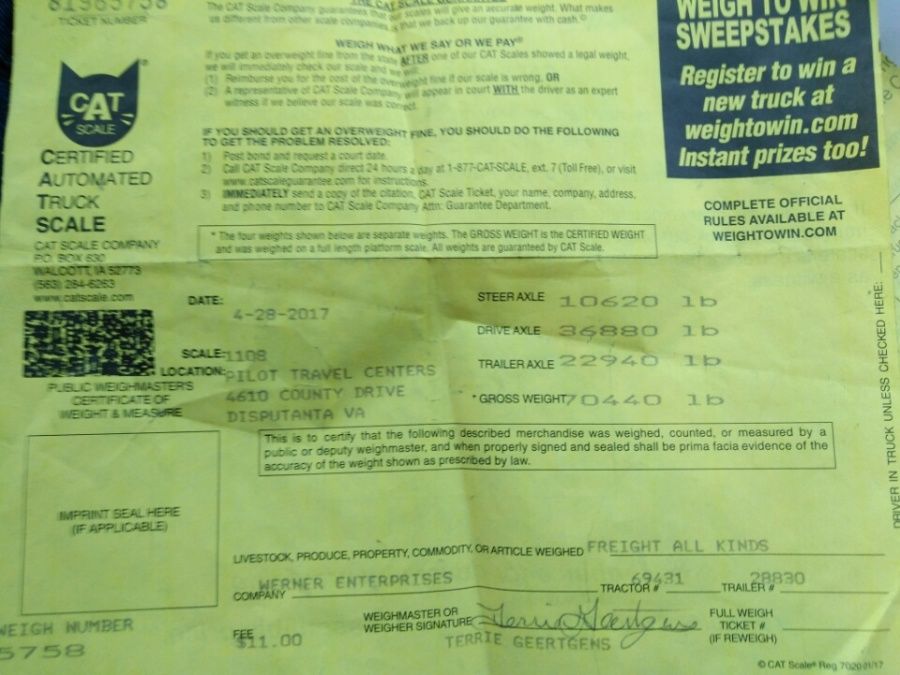Overweight Scale Ticket
Topic 19406 | Page 1

Did you slide the tandems?
Tandems:
Tandem Axles
A set of axles spaced close together, legally defined as more than 40 and less than 96 inches apart by the USDOT. Drivers tend to refer to the tandem axles on their trailer as just "tandems". You might hear a driver say, "I'm 400 pounds overweight on my tandems", referring to his trailer tandems, not his tractor tandems. Tractor tandems are generally just referred to as "drives" which is short for "drive axles".
Tandem:
Tandem Axles
A set of axles spaced close together, legally defined as more than 40 and less than 96 inches apart by the USDOT. Drivers tend to refer to the tandem axles on their trailer as just "tandems". You might hear a driver say, "I'm 400 pounds overweight on my tandems", referring to his trailer tandems, not his tractor tandems. Tractor tandems are generally just referred to as "drives" which is short for "drive axles".

2nd question, are you able to slide the tandems? There are states that require a minimum king pin setting, and others that have a maximum king pin setting.
Ernie
Tandems:
Tandem Axles
A set of axles spaced close together, legally defined as more than 40 and less than 96 inches apart by the USDOT. Drivers tend to refer to the tandem axles on their trailer as just "tandems". You might hear a driver say, "I'm 400 pounds overweight on my tandems", referring to his trailer tandems, not his tractor tandems. Tractor tandems are generally just referred to as "drives" which is short for "drive axles".
Tandem:
Tandem Axles
A set of axles spaced close together, legally defined as more than 40 and less than 96 inches apart by the USDOT. Drivers tend to refer to the tandem axles on their trailer as just "tandems". You might hear a driver say, "I'm 400 pounds overweight on my tandems", referring to his trailer tandems, not his tractor tandems. Tractor tandems are generally just referred to as "drives" which is short for "drive axles".

We got it reworked before we left obviously.
Yes, the tandems were slid all the way up.
This is just to show that even a load of 33k can put you over if it's all loaded on the drivers.
Tandems:
Tandem Axles
A set of axles spaced close together, legally defined as more than 40 and less than 96 inches apart by the USDOT. Drivers tend to refer to the tandem axles on their trailer as just "tandems". You might hear a driver say, "I'm 400 pounds overweight on my tandems", referring to his trailer tandems, not his tractor tandems. Tractor tandems are generally just referred to as "drives" which is short for "drive axles".
Tandem:
Tandem Axles
A set of axles spaced close together, legally defined as more than 40 and less than 96 inches apart by the USDOT. Drivers tend to refer to the tandem axles on their trailer as just "tandems". You might hear a driver say, "I'm 400 pounds overweight on my tandems", referring to his trailer tandems, not his tractor tandems. Tractor tandems are generally just referred to as "drives" which is short for "drive axles".

2 Questions:
What's your tare weight?
Why is your fifth wheel that far back?

Yes, my fifth wheel is pretty far back. I just got a new truck with 33 miles on it and waiting to get a decent load of 40-44k to set my fifth wheel. Have happened yet. Lol.
My tare weight? Last truck i weighed with an empty trailer was like 34k.
2 Questions:
What's your tare weight?
Why is your fifth wheel that far back?

Taxman wrote:
2 Questions:
What's your tare weight?
Why is your fifth wheel that far back?
A bit presumptuous for someone not in school yet...
His tare weight is the lading weight of 33k subtracted from the gross weight of 70,440. What is your point...?
If he is running a reefer , 37k tare weight is about right, otherwise the bill weight is not accurate, too low. The fifth wheel setting is of no consequence, the high weight on the drives and low weight on the tandems created tremendous imbalance. He fixed it.
What really matters is the axle weights and the gross. Rule of thumb and he followed it, anything over 32k, weigh it. If he has a bag gauge he could tell if his drive weights were really high. He handled this correctly.
Again...your point for asking these questions?
Tandems:
Tandem Axles
A set of axles spaced close together, legally defined as more than 40 and less than 96 inches apart by the USDOT. Drivers tend to refer to the tandem axles on their trailer as just "tandems". You might hear a driver say, "I'm 400 pounds overweight on my tandems", referring to his trailer tandems, not his tractor tandems. Tractor tandems are generally just referred to as "drives" which is short for "drive axles".
Tandem:
Tandem Axles
A set of axles spaced close together, legally defined as more than 40 and less than 96 inches apart by the USDOT. Drivers tend to refer to the tandem axles on their trailer as just "tandems". You might hear a driver say, "I'm 400 pounds overweight on my tandems", referring to his trailer tandems, not his tractor tandems. Tractor tandems are generally just referred to as "drives" which is short for "drive axles".
Reefer:
A refrigerated trailer.

Yes, my fifth wheel is pretty far back. I just got a new truck with 33 miles on it and waiting to get a decent load of 40-44k to set my fifth wheel. Have happened yet. Lol.
Looks like you had 47,500 on your steers and drives today. Would balancing it to 12,100 + 45,400 have gotten your fifth wheel in a good enough spot?

He needs to be at or below 12k on the steers. I don't think he had enough available holes to move almost 3000 pounds off the drives.
New Reply:
New! Check out our help videos for a better understanding of our forum features

















Preview:









 TT On Facebook
TT On Facebook
Here's our scale ticket. Bills said 33,000.
Steers:10620 Drives:36880 Trailer:22940 Gross: 70440